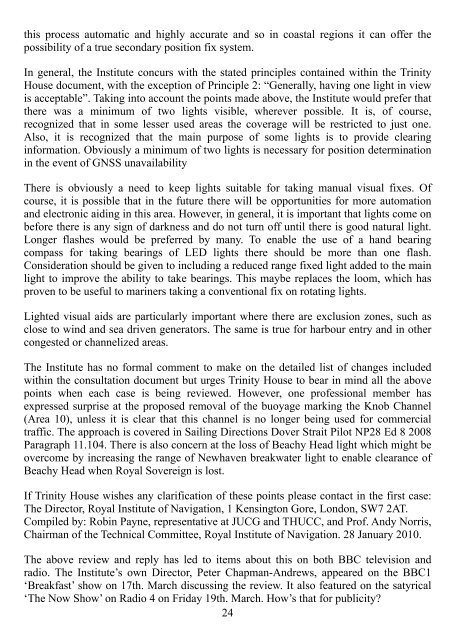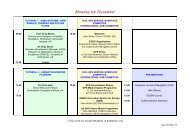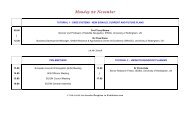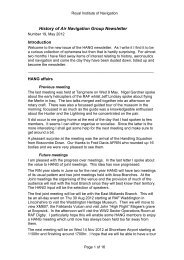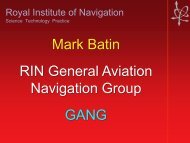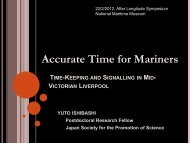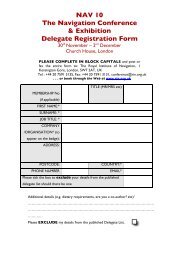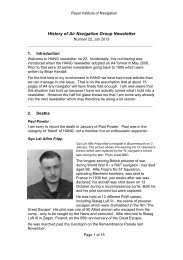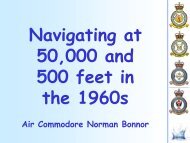Fairway 30 - Royal Institute of Navigation
Fairway 30 - Royal Institute of Navigation
Fairway 30 - Royal Institute of Navigation
You also want an ePaper? Increase the reach of your titles
YUMPU automatically turns print PDFs into web optimized ePapers that Google loves.
this process automatic and highly accurate and so in coastal regions it can <strong>of</strong>fer the<br />
possibility <strong>of</strong> a true secondary position fix system.<br />
In general, the <strong>Institute</strong> concurs with the stated principles contained within the Trinity<br />
House document, with the exception <strong>of</strong> Principle 2: “Generally, having one light in view<br />
is acceptable”. Taking into account the points made above, the <strong>Institute</strong> would prefer that<br />
there was a minimum <strong>of</strong> two lights visible, wherever possible. It is, <strong>of</strong> course,<br />
recognized that in some lesser used areas the coverage will be restricted to just one.<br />
Also, it is recognized that the main purpose <strong>of</strong> some lights is to provide clearing<br />
information. Obviously a minimum <strong>of</strong> two lights is necessary for position determination<br />
in the event <strong>of</strong> GNSS unavailability<br />
There is obviously a need to keep lights suitable for taking manual visual fixes. Of<br />
course, it is possible that in the future there will be opportunities for more automation<br />
and electronic aiding in this area. However, in general, it is important that lights come on<br />
before there is any sign <strong>of</strong> darkness and do not turn <strong>of</strong>f until there is good natural light.<br />
Longer flashes would be preferred by many. To enable the use <strong>of</strong> a hand bearing<br />
compass for taking bearings <strong>of</strong> LED lights there should be more than one flash.<br />
Consideration should be given to including a reduced range fixed light added to the main<br />
light to improve the ability to take bearings. This maybe replaces the loom, which has<br />
proven to be useful to mariners taking a conventional fix on rotating lights.<br />
Lighted visual aids are particularly important where there are exclusion zones, such as<br />
close to wind and sea driven generators. The same is true for harbour entry and in other<br />
congested or channelized areas.<br />
The <strong>Institute</strong> has no formal comment to make on the detailed list <strong>of</strong> changes included<br />
within the consultation document but urges Trinity House to bear in mind all the above<br />
points when each case is being reviewed. However, one pr<strong>of</strong>essional member has<br />
expressed surprise at the proposed removal <strong>of</strong> the buoyage marking the Knob Channel<br />
(Area 10), unless it is clear that this channel is no longer being used for commercial<br />
traffic. The approach is covered in Sailing Directions Dover Strait Pilot NP28 Ed 8 2008<br />
Paragraph 11.104. There is also concern at the loss <strong>of</strong> Beachy Head light which might be<br />
overcome by increasing the range <strong>of</strong> Newhaven breakwater light to enable clearance <strong>of</strong><br />
Beachy Head when <strong>Royal</strong> Sovereign is lost.<br />
If Trinity House wishes any clarification <strong>of</strong> these points please contact in the first case:<br />
The Director, <strong>Royal</strong> <strong>Institute</strong> <strong>of</strong> <strong>Navigation</strong>, 1 Kensington Gore, London, SW7 2AT.<br />
Compiled by: Robin Payne, representative at JUCG and THUCC, and Pr<strong>of</strong>. Andy Norris,<br />
Chairman <strong>of</strong> the Technical Committee, <strong>Royal</strong> <strong>Institute</strong> <strong>of</strong> <strong>Navigation</strong>. 28 January 2010.<br />
The above review and reply has led to items about this on both BBC television and<br />
radio. The <strong>Institute</strong>’s own Director, Peter Chapman-Andrews, appeared on the BBC1<br />
‘Breakfast’ show on 17th. March discussing the review. It also featured on the satyrical<br />
‘The Now Show’ on Radio 4 on Friday 19th. March. How’s that for publicity?<br />
24


